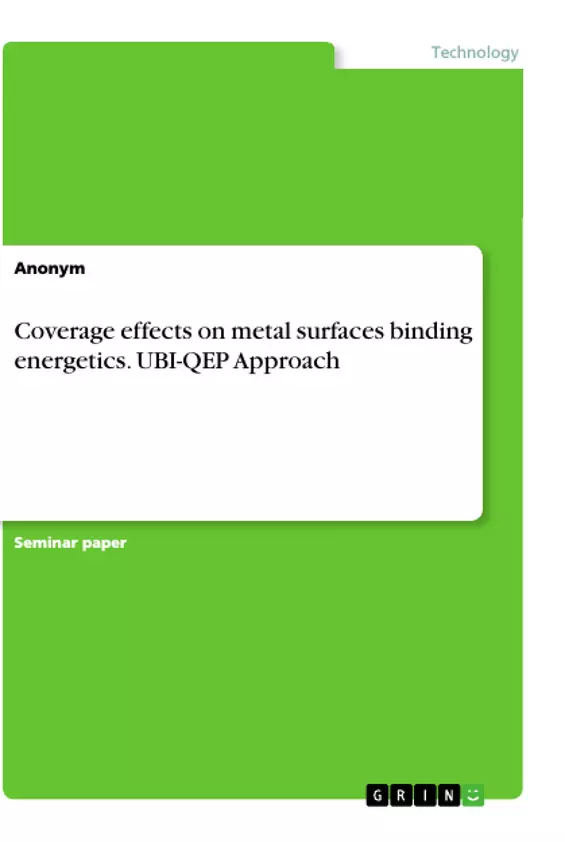This paper presents a unified formulation of the unity bond index-quadratic exponential potential method (UBI-QEP, formerly known as the BOC-MP method) for determining equilibrium coverage-dependent atomic binding energies as a result of coverage effect, the basic UBI-QEP parameters and correlation between local and global adsorbate coverage is briefly clarified, then coadsorption effects on reaction energetic on monometallic surfaces and most important cases of coverage effects on fcc(111) and fcc(100) surfaces is reviewed, the different metal atom and adatoms interactions are also looked at followed by their respective heats of adsorption at non-zero coverage limits i.e. metal atoms with identical adatoms, A and different adatoms, A and B, diadatoms AB, including a brief review on polyatomics.
Inhaltsverzeichnis (Table of Contents)
- Abstract
- 1.0 Introduction
- 2.0 Different UBI-QEP formulas for atomic and molecular adsorption at varying coverages
- 2.1 Local σl and global σg scaling factors
- 2.1.1 Local factor σl
- 2.1.2 Global Scaling Factor σg
- 3.0 UBI-QEP energetics on metallic surfaces
- 3.1 Atomic Adsorption at a Nonzero Coverage with identical adatoms
- 3.1.1 Coverage effects on metal surfaces with different arrangements
- 3.2 Atomic adsorption at a nonzero coverage with different adatoms
- 3.3 Adsorption of Diatomic Molecules at Nonzero Coverages
- 3.4 Adsorption of Polyatomic Molecules
- 4.0 Conclusion
- 5.0 References
Zielsetzung und Themenschwerpunkte (Objectives and Key Themes)
This paper aims to provide a unified formulation of the UBI-QEP method for determining equilibrium coverage-dependent atomic binding energies. It explores the coverage effect, clarifies the basic UBI-QEP parameters, and examines the correlation between local and global adsorbate coverage. The paper also reviews coadsorption effects on reaction energetics on monometallic surfaces, focusing on coverage effects on fcc(111) and fcc(100) surfaces. It further investigates different metal atom and adatatom interactions, including their heats of adsorption at non-zero coverage limits.
- Coverage dependence effects on heats of adsorption
- UBI-QEP method and its application in determining binding energies
- Coadsorption effects on reaction energetics on monometallic surfaces
- Interactions between metal atoms and adatatoms
- Heats of adsorption at non-zero coverage limits
Zusammenfassung der Kapitel (Chapter Summaries)
- 1.0 Introduction: Introduces the UBI-QEP method, its historical background, and its applications in predicting adsorption energies and activation energies for various species on transition metal surfaces.
- 2.0 Different UBI-QEP formulas for atomic and molecular adsorption at varying coverages: Explains the local and global scaling factors used to describe the binding energy changes of adatoms under non-zero coverage effects.
- 3.0 UBI-QEP energetics on metallic surfaces: Investigates various aspects of atomic and molecular adsorption on metallic surfaces at non-zero coverages, including different adatom arrangements, coadsorption effects, and diatomic and polyatomic molecule adsorption.
Schlüsselwörter (Keywords)
The paper focuses on the UBI-QEP method, coverage effects, coadsorption effects, heats of adsorption, and scaling factors. It investigates the energetics of adsorption on metallic surfaces, particularly fcc(111) and fcc(100) surfaces. The study involves different metal atom and adatatom interactions, emphasizing the concept of non-zero coverage limits.
- Quote paper
- Anonym (Author), 2014, Coverage effects on metal surfaces binding energetics. UBI-QEP Approach, Munich, GRIN Verlag, https://www.hausarbeiten.de/document/915385


